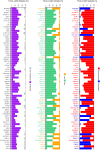Differentially expressed microRNAs in lung adenocarcinoma invert effects of copy number aberrations of prognostic genes
- PMID: 29507679
- PMCID: PMC5823624
- DOI: 10.18632/oncotarget.24070
Differentially expressed microRNAs in lung adenocarcinoma invert effects of copy number aberrations of prognostic genes
Abstract
In many cancers, significantly down- or upregulated genes are found within chromosomal regions with DNA copy number alteration opposite to the expression changes. Generally, this paradox has been overlooked as noise, but can potentially be a consequence of interference of epigenetic regulatory mechanisms, including microRNA-mediated control of mRNA levels. To explore potential associations between microRNAs and paradoxes in non-small-cell lung cancer (NSCLC) we curated and analyzed lung adenocarcinoma (LUAD) data, comprising gene expressions, copy number aberrations (CNAs) and microRNA expressions. We integrated data from 1,062 tumor samples and 241 normal lung samples, including newly-generated array comparative genomic hybridization (aCGH) data from 63 LUAD samples. We identified 85 "paradoxical" genes whose differential expression consistently contrasted with aberrations of their copy numbers. Paradoxical status of 70 out of 85 genes was validated on sample-wise basis using The Cancer Genome Atlas (TCGA) LUAD data. Of these, 41 genes are prognostic and form a clinically relevant signature, which we validated on three independent datasets. By meta-analysis of results from 9 LUAD microRNA expression studies we identified 24 consistently-deregulated microRNAs. Using TCGA-LUAD data we showed that deregulation of 19 of these microRNAs explains differential expression of the paradoxical genes. Our results show that deregulation of paradoxical genes is crucial in LUAD and their expression pattern is maintained epigenetically, defying gene copy number status.
Keywords: copy number aberrations; gene regulatory network; lung adenocarcinoma; microRNA; prognostic signature.
Conflict of interest statement
CONFLICTS OF INTEREST The authors declare no conflicts of interest.
Figures







Similar articles
-
Systematic identification of lincRNA-based prognostic biomarkers by integrating lincRNA expression and copy number variation in lung adenocarcinoma.Int J Cancer. 2019 Apr 1;144(7):1723-1734. doi: 10.1002/ijc.31865. Epub 2018 Dec 12. Int J Cancer. 2019. PMID: 30226269
-
High ECT2 expression is an independent prognostic factor for poor overall survival and recurrence-free survival in non-small cell lung adenocarcinoma.PLoS One. 2017 Oct 31;12(10):e0187356. doi: 10.1371/journal.pone.0187356. eCollection 2017. PLoS One. 2017. PMID: 29088286 Free PMC article.
-
Identification of dysregulated long non-coding RNAs/microRNAs/mRNAs in TNM I stage lung adenocarcinoma.Oncotarget. 2017 Jun 16;8(31):51703-51718. doi: 10.18632/oncotarget.18512. eCollection 2017 Aug 1. Oncotarget. 2017. PMID: 28881680 Free PMC article.
-
Sideroflexin1 as a novel tumor marker independently predicts survival in lung adenocarcinoma.Transl Cancer Res. 2019 Aug;8(4):1170-1178. doi: 10.21037/tcr.2019.06.34. Transl Cancer Res. 2019. PMID: 35116859 Free PMC article.
-
Integrated analysis of long non-coding RNA‑associated ceRNA network reveals potential lncRNA biomarkers in human lung adenocarcinoma.Int J Oncol. 2016 Nov;49(5):2023-2036. doi: 10.3892/ijo.2016.3716. Epub 2016 Sep 30. Int J Oncol. 2016. PMID: 27826625
Cited by
-
A comprehensive molecular characterization of the 8q22.2 region reveals the prognostic relevance of OSR2 mRNA in muscle invasive bladder cancer.PLoS One. 2021 Mar 12;16(3):e0248342. doi: 10.1371/journal.pone.0248342. eCollection 2021. PLoS One. 2021. PMID: 33711044 Free PMC article.
-
GSOAP: a tool for visualization of gene set over-representation analysis.Bioinformatics. 2020 May 1;36(9):2923-2925. doi: 10.1093/bioinformatics/btaa001. Bioinformatics. 2020. PMID: 31977031 Free PMC article.
-
Expanding the Transcriptome of Head and Neck Squamous Cell Carcinoma Through Novel MicroRNA Discovery.Front Oncol. 2019 Nov 27;9:1305. doi: 10.3389/fonc.2019.01305. eCollection 2019. Front Oncol. 2019. PMID: 31828039 Free PMC article.
-
Why imaging data alone is not enough: AI-based integration of imaging, omics, and clinical data.Eur J Nucl Med Mol Imaging. 2019 Dec;46(13):2722-2730. doi: 10.1007/s00259-019-04382-9. Epub 2019 Jun 15. Eur J Nucl Med Mol Imaging. 2019. PMID: 31203421 Review.
-
Global microRNA expression profile in laryngeal carcinoma unveils new prognostic biomarkers and novel insights into field cancerization.Sci Rep. 2022 Oct 12;12(1):17051. doi: 10.1038/s41598-022-20338-w. Sci Rep. 2022. PMID: 36224266 Free PMC article.
References
-
- Phillips JL, Hayward SW, Wang Y, Vasselli J, Pavlovich C, Padilla-Nash H, Pezullo JR, Ghadimi BM, Grossfeld GD, Rivera A, Linehan WM, Cunha GR, Ried T. The consequences of chromosomal aneuploidy on gene expression profiles in a cell line model for prostate carcinogenesis. Cancer Res. 2001;61:8143–9. - PubMed
-
- Hyman E, Kauraniemi P, Hautaniemi S, Wolf M, Mousses S, Rozenblum E, Ringnér M, Sauter G, Monni O, Elkahloun A, Kallioniemi OP, Kallioniemi A. Impact of DNA amplification on gene expression patterns in breast cancer. Cancer Res. 2002;62:6240–5. - PubMed
-
- Pollack JR, Sørlie T, Perou CM, Rees CA, Jeffrey SS, Lonning PE, Tibshirani R, Botstein D, Børresen-Dale AL, Brown PO. Microarray analysis reveals a major direct role of DNA copy number alteration in the transcriptional program of human breast tumors. Proc Natl Acad Sci. 2002;99:12963–8. - PMC - PubMed
-
- Järvinen AK, Autio R, Haapa-Paananen S, Wolf M, Saarela M, Grenman R, Leivo I, Kallioniemi O, Mäkitie AA, Monni O. Identification of target genes in laryngeal squamous cell carcinoma by high-resolution copy number and gene expression microarray analyses. Oncogene. 2006;25:6997–7008. - PubMed
LinkOut - more resources
Full Text Sources
Other Literature Sources

